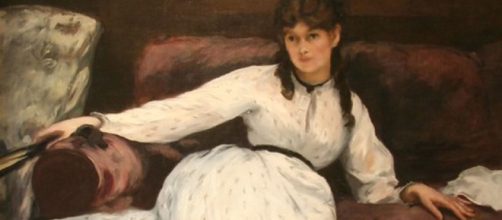What does a portrait of love look like? Three art critics think Edouard Manet’s painting of Berthe Morisot – “Le Repos” – delivers. I don’t and wonder if we’re all talking about the same picture.
The Washington Post art critic Sebastian Smee wrote last week that Manet’s portrait is “a lesson in how to love.” He sounded adamant: “Ardor was never more evident than when he painted Berthe Morisot.”
To support this claim, Smee cited a description by The New Yorker art critic Peter Schjeldahl in 2005 of Morisot’s clothing in “Le Pos”: “Beneath [Morisot’s] petticoats, twisting athwart their arrangement, her body is wild.
Wild not with desire … but with the thoughtless animal energy that both desires and induces desire.”
But all I see in this portrait – now in a newly restored period frame at the Rhode Island School of Design Museum – is Morisot slouching awkwardly on a couch.
Even Smee noticed Morisot’s uncomfortable-looking pose, saying she looks “a little fed up, you feel, with posing, perhaps eager to get back to her own easel.”
Smee’s thought about Morisot wanting to get back to her work is a good guess. She was a serious painter, having received art training from the great neo-classicist Jean-Auguste-Dominique Ingres, not some femme fatale the way Manet pictured her.
Intent on her work, Morisot even avoided marriage until age 33, which was an advanced age for unmarried women in her day.
If Manet loved her the way Smee and Schjeldahl say he did, why didn’t he ever picture her in his numerous portraits of her at work, painting?
These critics argue further that Manet’s portrait of Morisot is the picture of love. Smee quotes Schjeldahl commenting on the Japanese print on the wall behind Morisot. He described it as “a crashing waves and tumbling bodies,” adding that its “inclusion makes explicit an erotic tumult just below the surface of Manet’s painting.” That’s his proof of love in this picture – a wave crashing over people’s heads?
Piling on
And here comes the third art critic who sees love between Manet and Morisot in “Le Repos.” Jeffrey Mayers wrote in The New Criterion in 2005 about “the intimate” relationship between Morisot and Manet.
According to Mayers, Morisot’s letters to her sister about Manet “strongly suggest that they were lovers.” His reasoning? “Often alone together in his studio, they had ample time for intimacy.”
By that logic, the four years that Mona Lisa sat for her portrait made Da Vinci her lover. And we all know his lover was his student Gian Giacomo Caprotti da Oreno, a.k.a. Salaì.
Besides, if Manet loved Morisot as Mayers believes, why did he mock her to the Irish novelist George Moore who reported the jibe in his 1911 memoirs “Hail and Farewell.” Referring to Morisot’s marriage to his brother Eugene, he said: “My sister-in-law wouldn’t have been noticed without me.”
Au contraire
But Morisot was no dabbler who caught a break by marrying a Manet.
Fully a decade before her marriage, at age 23, the official Parisian Salon accepted two of her paintings. Unusual for a female painter at the time.
And she went on from there having her work regularly accepted at prestigious state-run exhibits well over a decade before the Impressionists became known.
Apparently, Morisot was aware of Manet’s disparaging remarks. Historian Jean-Dominique Rey quotes her in her 2019 book “Berthe Morisot” saying: “I do not think any man would ever treat a woman as his equal, and it is all I ask, because I know my worth.”
One last point, and maybe the most important one when it comes to thinking “Le Pos” a portrait of love. Art historian Anne Higonnet observed in her 1978 book on Morisot the admiring way she looks at Manet when he painted her: “She is not merely the object of his vision but a respondent to his art.”
In other words, his portraits of her are really about him.


